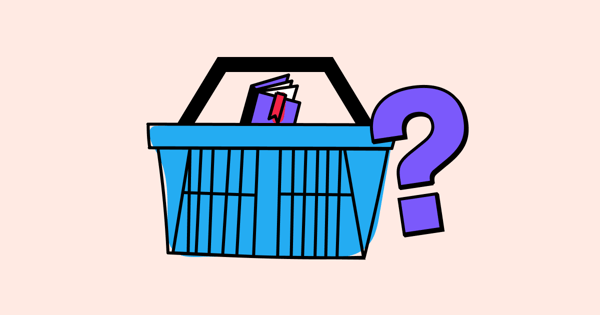Shopping cart abandonment is the eternal nemesis of ecommerce store owners.
I can say from experience that it’s incredibly frustrating to successfully move a shopper through the sales funnel and create offers that are enticing enough to pique their interest, only to inevitably lose them at the point of purchase.
It’s incredibly frustrating.
So, I decided to cover various cart abandonment statistics to explain why shoppers don't complete purchases and how to address these common issues, in five categories:
- 3 Key Cart Abandonment Rate Statistics: A Quick Overview
- 8 Reasons Why Consumers Abandon Cart
- 4. Extra Costs are the Number One Reason Why Shoppers Abandon
- 5. Being Forced to Create an Account is the Number Two Reason People Abandon
- 6. 57 Percent of Shoppers Will Abandon if They Have to Wait Three Seconds for a Page to Load
- 7. 55 Percent of Shoppers Will Abandon if They Have to Re-Enter Their Credit Card or Shipping Information
- 8. 46 Percent of Shoppers Abandon Because a Discount Code Doesn’t Work
- 9. Dissatisfactory Return Policies Force 10 Percent Of Shoppers To Drop Their Purchase Mid-Way
- 10. 22 Percent Of Shoppers Abandon Because Of Long Delivery Times
- 11. Consumers Use Shopping Carts As Their Virtual Shopping Lists
- 4 Cart Abandonment Statistics on Checkout Flow Best Practices
- 12. Checkout Optimization Can Increase Conversions by 35.62 Percent
- 13. The Average Checkout Flow Has 23.48 Form Elements and 14.88 Form Fields
- 14. A Fully Optimized Checkout Flow Can Have as Few as 12 Form Elements and 7 Form Fields
- 15. 40 Percent Of Shoppers Are Likely To Abandon Their Purchase If An Online Store Doesn’t Have Multiple Payment Options
- 2 Methods To Slash Cart Abandonment Rate For Mobile Devices
- 4 Ways To Do Cart Abandonment Recovery right
That way you can avoid making unnecessary mistakes, create a friction-free customer experience and increase conversions.
With that said, here are 21 up-to-date cart abandonment statistics you need to know.
3 Key Cart Abandonment Rate Statistics: A Quick Overview
1. The Average Cart Abandonment Rate Across All Industries is 69.57 Percent
Google “shopping cart abandonment rate,” and you’ll find data from a ton of different studies.
I’ve seen rates as low as 56 percent and as high as 81 percent.
However, I think recent data from the Baymard Institute paints the most accurate picture.
They calculated data from 41 different studies and found that the average cart abandonment rate is just under 70 percent.
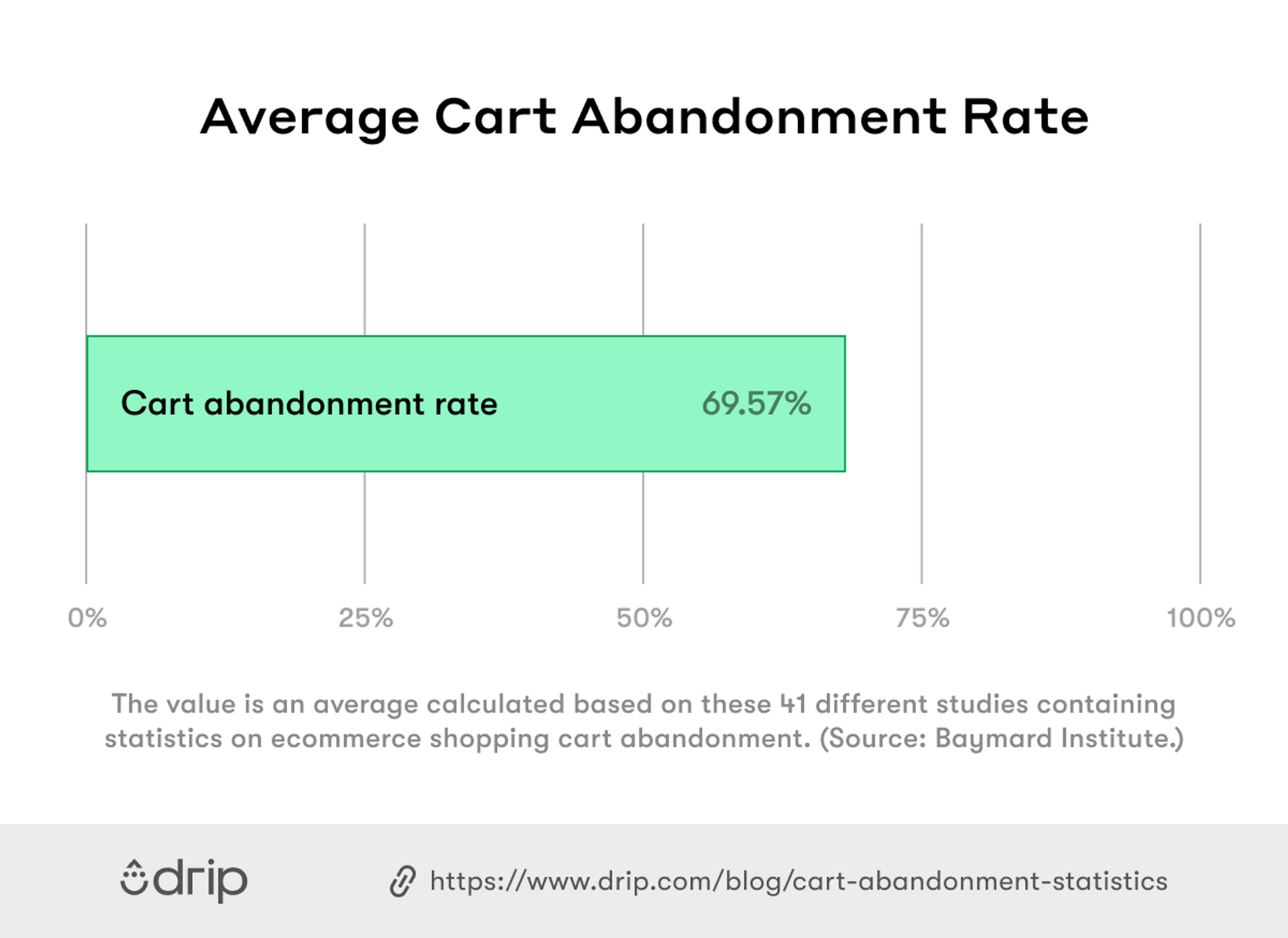 That means roughly seven out of every 10 shoppers won’t complete their transaction—a number many ecommerce store owners find troubling.
That means roughly seven out of every 10 shoppers won’t complete their transaction—a number many ecommerce store owners find troubling.
2. Ecommerce Brands Lose $18 Billion in Sales Revenue Each Year Because of Cart Abandonment
In terms of impact on revenue, it’s quite severe at $18 billion annually.
And as content strategy writer, Meir Fox explains,
With $4 trillion worth of merchandise predicted to be abandoned in digital carts next year alone, cart abandonment has become a burning issue that ecommerce organizations can no longer afford to ignore.
So it’s an issue that demands top priority.
3. Employing Predictive AI Can Reduce Cart Abandonment Rate By 18%
JCPenney used a predictive AI model to analyze site visitors' behavior and identify potential cart abandonment indicators before the shoppers left the site.
This enabled them to create hyper-specific campaigns for troubled customer segments with tailored content and offers.
Plus, the unique behavioral thumbprint helped them understand individual customer preferences and optimize shopping experiences with personalized recommendations, pricing, and promotions.
Predicting abandonment allowed real-time interventions — when buyers were about to exit the website — with targeted messages or incentives, like limited-time discounts.
Most strikingly, the AI model not only decreased cart abandonment but also protected their profit margins by optimizing offers and discounts for conversions without sacrificing profitability.
And this combination helped them reduce their cart abandonment rate by 18%.
8 Reasons Why Customers Abandon Carts
4. Extra Costs are the Number One Reason Why Shoppers Abandon
The Baymard Institute also performed some in-depth research to determine what triggers cart abandonment.
While there are several different factors, extra costs like shipping, taxes, and fees were hands down the biggest dealbreaker.
Fifty-five percent of survey respondents cited this as being the reason why they abandon.
This shows why it’s so important to be transparent with extra costs.
That’s what custom deodorant company, Myro does on their checkout page.
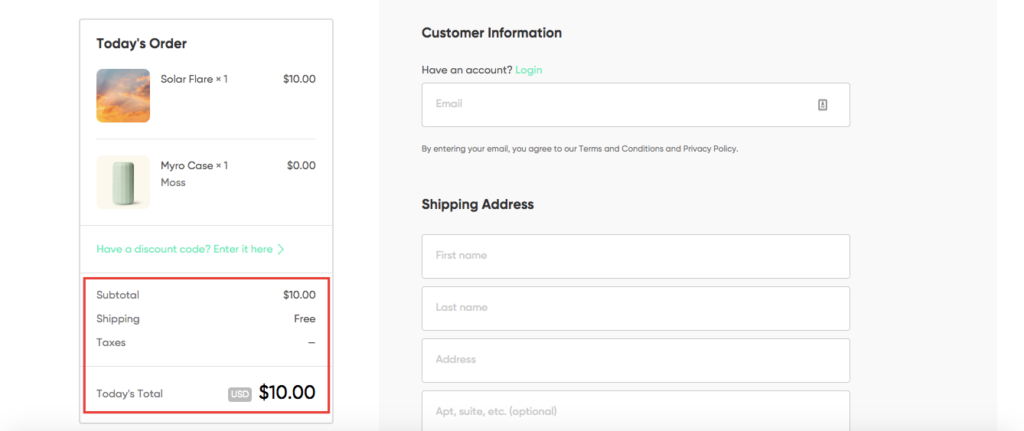 There you see the exact total including shipping and taxes so that you know exactly what you’ll pay.
There you see the exact total including shipping and taxes so that you know exactly what you’ll pay.
That way there are no surprises at this critical juncture in the sales funnel.
This statistic also shows that you should heavily consider offering free or at least discounted shipping.
Seventy-nine percent of people are more likely to shop online when there’s free shipping. So, if you’re not doing it already, consider offering free shipping as an incentive in your cart abandonment emails.
5. Being Forced to Create an Account is the Number Two Reason People Abandon
“The site wanted me to create an account” also factored in heavily to cart abandonment, with 34 percent of respondents saying they abandoned for this reason.
I don’t know about you, but I hate having to go through the redundant process of creating an account, especially if I only plan on making a one-time order.
And apparently, over a third of ecommerce shoppers feel the same.
So I highly recommend offering a guest checkout where shoppers can conveniently make a purchase without having to go to all the trouble of setting up an account.
That’s something furniture and home decor company, Crate & Barrel does, which makes for a smooth, seamless customer experience.
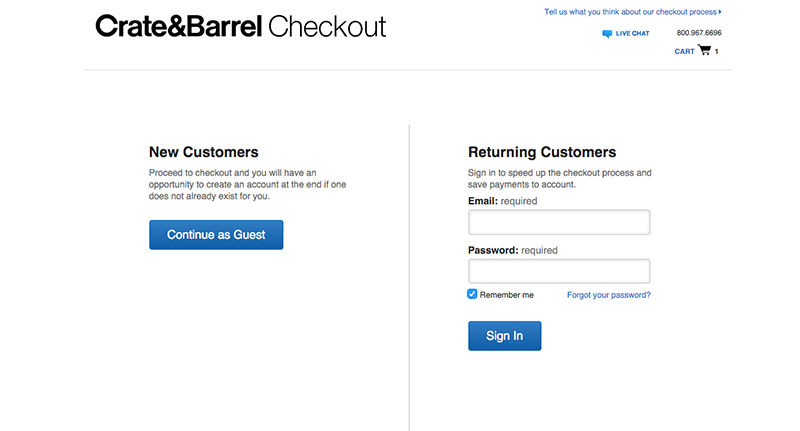
6. 57 Percent of Shoppers Will Abandon if They Have to Wait Three Seconds for a Page to Load
I probably don’t need to tell you that most digital shoppers are a little impatient these days.
But this statistic shows you exactly how long you have before the majority of could-be customers leave your site.
And what’s even scarier is that 80 percent of these customers will never return.
Once they know your site is sluggish, most will avoid it like the plague.
So you need to put a lot of effort into improving site speed and go the extra mile to keep load time under three seconds for all pages.
7. 55 Percent of Shoppers Will Abandon if They Have to Re-Enter Their Credit Card or Shipping Information
Piggybacking off of my last point, this statistic shows that any major redundancy in the checkout process negatively impacts conversions as well.
Statista found that 30 percent of shoppers will leave if they have to re-enter their credit card information, and 25 percent will leave if they have to re-enter their shipping information.
So you need to be sure that shoppers don’t run into this issue on your site.
A simple way to eliminate this problem with shipping information is to automatically populate these fields with the shopper’s billing information and make that the default.
Since a good chunk of people will have the same billing and shipping information, this can eliminate a step.
8. 46 Percent of Shoppers Abandon Because a Discount Code Doesn’t Work
The overwhelming majority of consumers use coupons at 90 percent.
And 75 percent now expect brands to offer them.
This is no doubt an effective way to drum up new business and instill loyalty in existing customers.
When everything goes smoothly, offering discount codes can increase conversions.
However, when shoppers run into issues where a discount code doesn’t work, nearly half (46 percent) will abandon their cart.
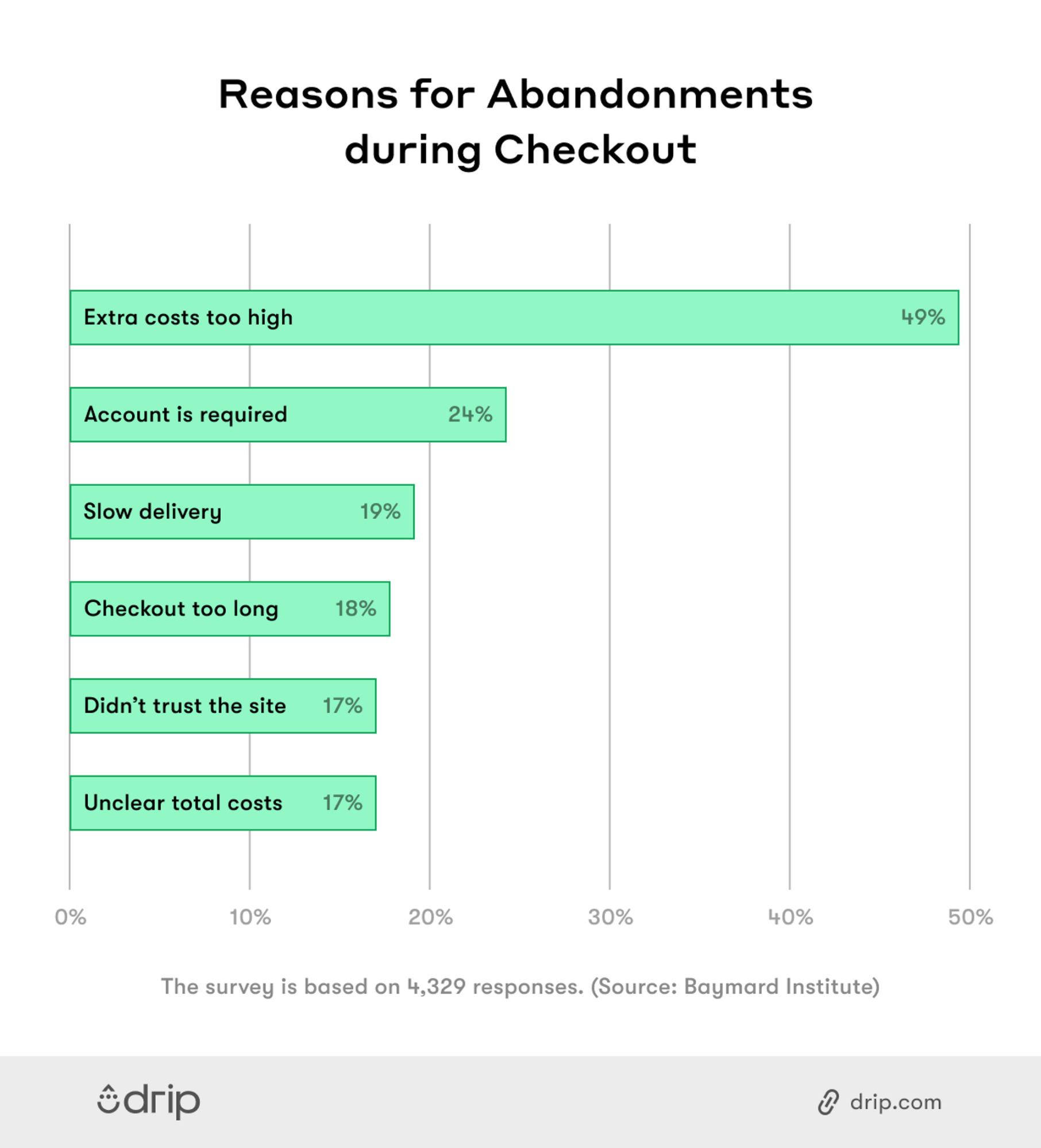 The point here is that offering promo codes is a good idea. But you need to be diligent in ensuring that everything works correctly. Otherwise, it’s going to create a lot of friction that will take a toll on conversions.
The point here is that offering promo codes is a good idea. But you need to be diligent in ensuring that everything works correctly. Otherwise, it’s going to create a lot of friction that will take a toll on conversions.
9. Dissatisfactory Return Policies Force 10 Percent Of Shoppers To Drop Their Purchase Mid-Way
Customer confidence in purchasing from you increases if they know they can return or exchange items if they’re not satisfied or encounter any issues.
On the flip side, when return policies are restrictive, complicated, or impose high costs on them, it can deter as many as 10% of them from finalizing their purchases, as ChargeBacks911 found in their research.
And when this happens, customers often drop negative reviews and spread bad word-of-mouth — kind of a death sentence for any company.
To craft a more customer-friendly and purchase-compelling return process:
- Display a straightforward and prominent return policy, avoiding confusing language or hidden clauses.A clever way to present your return policy is to visually include it right in your product pages, like Mokobara does.
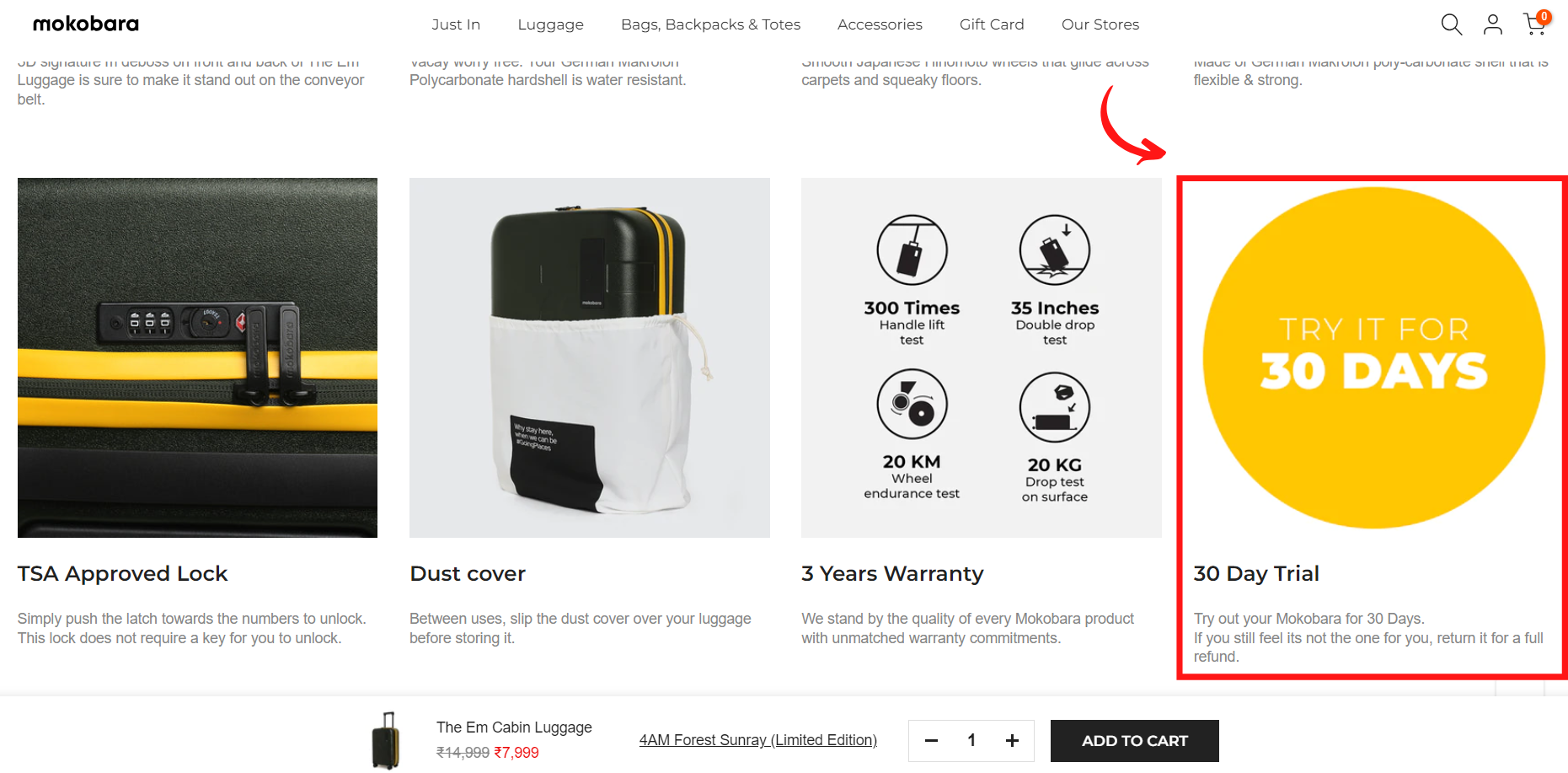
- Offer a reasonable and extended return time frame to allow ample trial time.
- Provide free return shipping, easing the financial burden.
- Allow multiple return methods, like in-store, mail-in, or drop-off locations, to offer flexibility.
- Simplify the return process with online forms and prepaid labels to minimize customer effort.
- Be lenient in accepting returns within reasonable guidelines, avoiding denial over minor issues.
- Train customer service reps to offer empathetic and personalized assistance to turn dissatisfied customers into loyal ones.
- Analyze return data for product quality improvement and reduce future returns.
10. 22 Percent Of Shoppers Abandon Because Of Long Delivery Times
We live and breathe the instant gratification kick. So, any form of delay is a killer!
Long delivery times not only push away 22% of consumers from hitting that payment button, but also increase your returns and refunds rate.
And this snowballs into loss of repeat business.
To address this issue:
- Set realistic delivery timeframes and be transparent during checkout
- Provide expedited shipping options for customers needing quicker delivery
- Use multiple reliable shipping carriers for flexibility and meeting deadlines
- Maintain accurate inventory levels to avoid out-of-stock situations
- Establish local warehouses for faster delivery in customer-dense locations
- Offer order tracking for customer transparency
- Notify customers of any delays promptly and provide updated estimates
11. Consumers Use Shopping Carts As Their Virtual Shopping Lists
Stetson University's School of Business Administration found near-purchase activity to be a reason for cart abandonment, and explained:
"Customers use shopping carts as a shopping list and may save items for a later time. They use it for price and shipping comparisons. They may shop online and then purchase in-store.”
During the initial stages of shopping, customers explore options, compare products, read reviews, and gather information before deciding.
And the cart is a practical way to save and organize items they find interesting or want to buy as it acts like a virtual shopping list, allowing them to curate options for later revisiting.
Plus, customers may use the cart as a wish list to store their favorite products they aren't ready to purchase yet. This helps them remember and potentially get back to those items sometime later when they’re ready to buy.
So, an abandoned cart is not always a missed sales opportunity.
4 Checkout Flow Best Practices To Reduce Cart Abandonment Rate
12. Checkout Optimization Can Increase Conversions by 35.62 Percent
The good news is that ecommerce brands aren’t doomed to suffer at the hands of cart abandonment.
Experts estimate that conversions can be increased by a whopping 35.62 percent by implementing the right checkout optimization strategies.
While reaching this number isn’t easy, it’s certainly possible.
At the end of the day, it all boils down to understanding what’s going wrong and making a concerted effort to improve ecommerce site design, promotions, offerings, checkout flow, and so on.
13. The Average Checkout Flow Has 23.48 Form Elements and 14.88 Form Fields
Shopping cart complexity and duration are two other critical factors that determine the likelihood of someone completing a purchase.
The Baymard Institute found that having too long or too complicated of a checkout process is the reason why over a quarter (26 percent) of shoppers abandon.
Separate research from the Baymard Institute found that on average, ecommerce stores had 23.48 form elements and 14.88 form fields for new non-account customers.
But experts say this is too many and creates points of friction during checkout.
“During testing, we consistently observe that users are overwhelmed and intimidated when seeing a high amount of form fields and selections,” The Baymard Institute explains.
This graph illustrates how UX performance diminishes as the number of form fields increase.
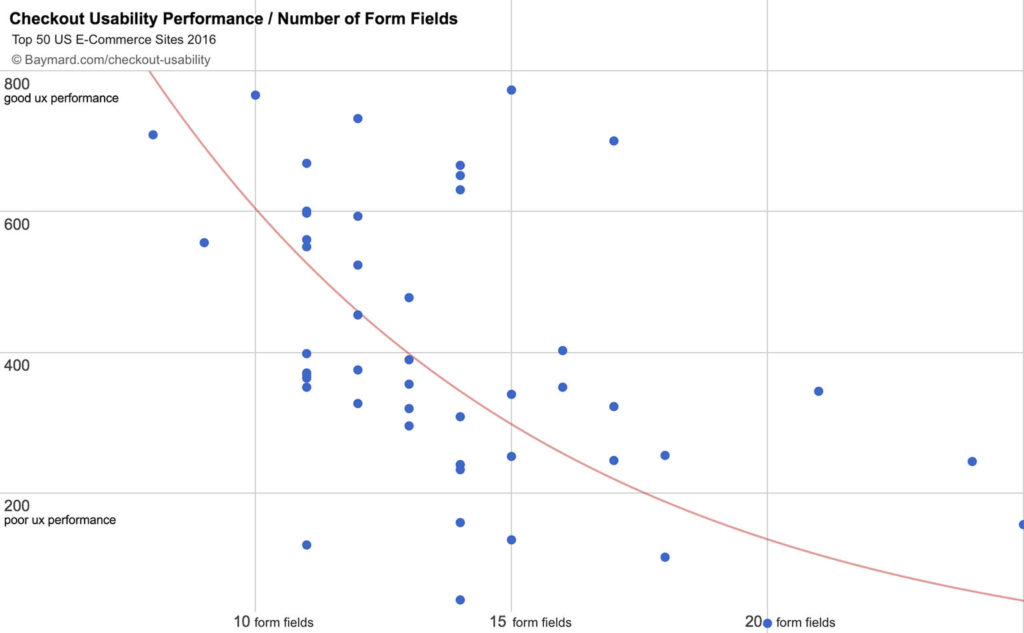
14. A Fully Optimized Checkout Flow Can Have as Few as 12 Form Elements and 7 Form Fields
But what’s interesting is that the top ecommerce sites with fully optimized checkout flows have roughly half as many form elements and form fields.
So following form design best practices should be a top priority for reducing cart abandonment.
Here are some specific ways to do that:
- Use a “full name” field rather than a first and last name field;
- Have customers enter their street address in one line; and
- Eliminate unnecessary optional fields.
If you’re looking for an example of a company that offers a super quick and easy checkout process, it’s electronics retailer, Crutchfield.
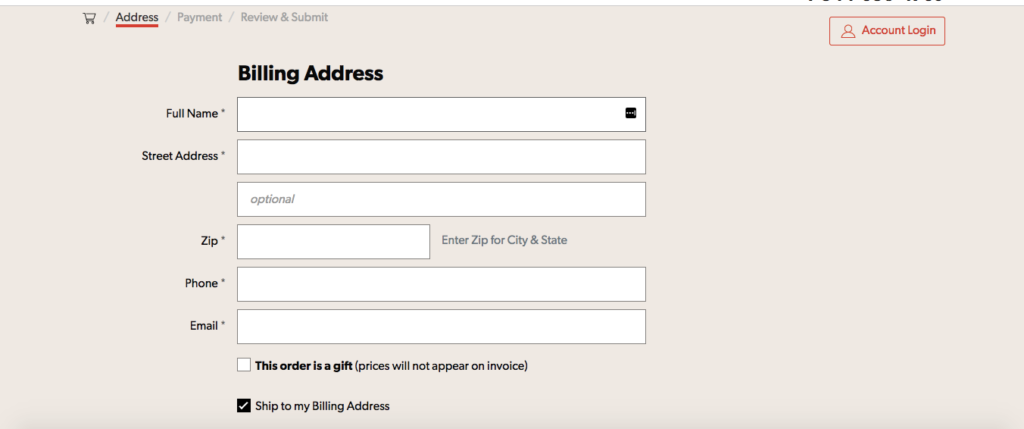 There are only five mandatory fields and one optional field.
There are only five mandatory fields and one optional field.
15. 40 Percent Of Shoppers Are Likely To Abandon Their Purchase If An Online Store Doesn’t Have Multiple Payment Options
For some, online shopping is a doorway to fill up their home and wardrobe with essentials. And for others, it’s a therapy.
Consumers are always looking to buy useful and desirable items, provided they can be had quickly, and most importantly via flexible payment options — like buy now, pay later (BNPL).
As per Adobe, brands experience 18% larger order size when they offer BNPL up against any other payment mode. Crazy, isn’t it?
If not BNPL, you must offer multiple payment options or risk losing the confidence of 40% of shoppers.
To rectify this situation, you can:
- Integrate diverse payment options, including credit/debit cards, digital wallets, installment plans, BNPL, and cash (if possible)
- Optimize the payment process for mobile users
- Accept multiple currencies for international customers
- Collaborate with reputable payment service providers for easy integration
- Clearly display accepted payment options and security measures
- Regularly test the payment process for continued functionality as expected
- Utilize customer data to personalize payment options for different customer segments
2 Methods To Slash Cart Abandonment Rate For Mobile Devices
16. Mobile Users Have an Even Higher Abandonment Rate of 85.65 Percent
“The smaller the size of the screen, the more likely a customer is to not purchase,” says Barilliance. “This is problematic considering that for the first time ever, more digital buyers will use smartphones than desktops to shop.”
This shows the importance of fully optimizing your ecommerce store for mobile users, which can be done with the following techniques:
- Increasing mobile site speed;
- Trimming down your copy to only include essential information;
- Using “mobile accordions” to effectively organize information; and
- Keeping critical elements above the fold.
Australian online fashion boutique, Amaroso is a great example of a brand that offers an amazing mobile experience.
It’s fast-loading, has a simple, intuitive design with key elements above the fold.
 It also makes use of the mobile accordion to quickly direct users to where they need to go.
It also makes use of the mobile accordion to quickly direct users to where they need to go.
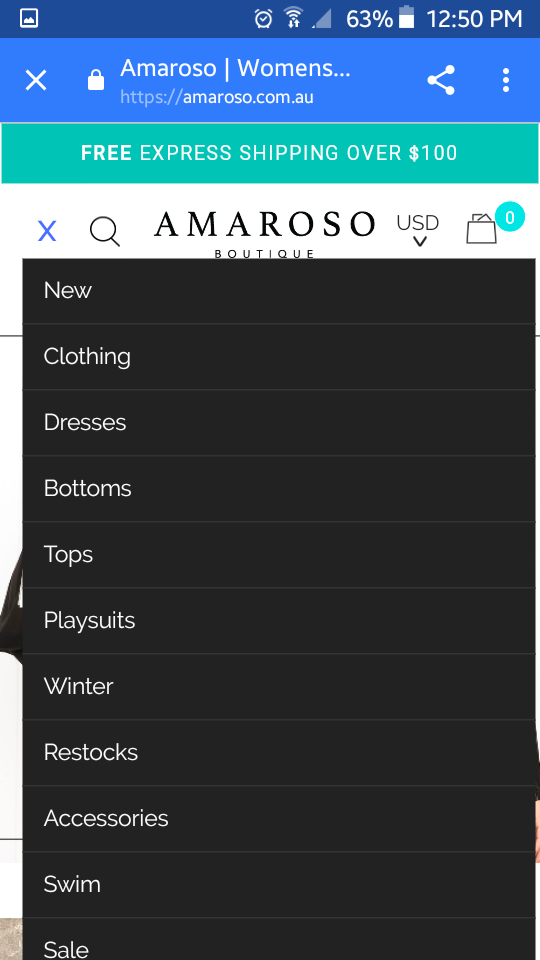 I also recommend getting in the habit of performing routine A/B testing so that you continually fine-tune the mobile experience and make it as seamless as possible.
I also recommend getting in the habit of performing routine A/B testing so that you continually fine-tune the mobile experience and make it as seamless as possible.
17. 39 Percent of Mobile Users Abandoned Because of Difficulty Entering Their Personal Information
One other issue that leads to nearly four out of 10 mobile users ditching their cart is trouble inputting their information during checkout.
This is primarily due to small buttons and an excessive number of form fields, which I mentioned before.
To resolve this issue, you’ll want:
- A mobile-responsive design for your ecommerce store;
- To use large buttons that can be easily tapped without accidentally hitting another element; and
- To keep forms short and sweet.
4 Ways To Do Cart Abandonment Recovery Right
18. Using Retargeted Ads Can Send 26 Percent of Shoppers Back to Your Site
So what about the shoppers that get away? Is all hope lost once they leave your site?
Fortunately, no. Using retargeted ads has proven to be an effective way to bring qualified leads back to your store.
Three out of four consumers notice retargeted ads—a percentage that’s encouraging considering that many people simply block out irrelevant ads.
Of those consumers, over a quarter (26 percent) will click on the retargeted ad and return to your site.
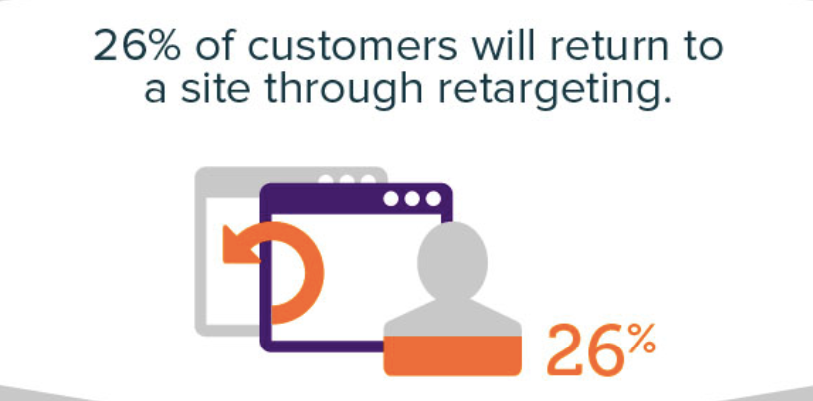 This makes it a highly effective technique and one worth considering.
This makes it a highly effective technique and one worth considering.
19. Personalizing Retargeted Ads Can Lead to ROIs of Over 1,300 Percent
Basic retargeting is helpful for bringing qualified leads back to your ecommerce site. But it has an even bigger impact when retargeted ads are personalized.
Brands that segment out different retargeting audience lists for people who behave differently have seen ROIs of more than 1,300 percent.
And as Growth Badger explains, “The more lists you can segment out, the better your results will be.”
So, for example, rather than simply displaying a generic ad promoting your company on a retargeted ad, you would want to feature the exact product a person added to their shopping cart before abandoning.
After checking out the “Gloria” shoes from Charlotte Stone…
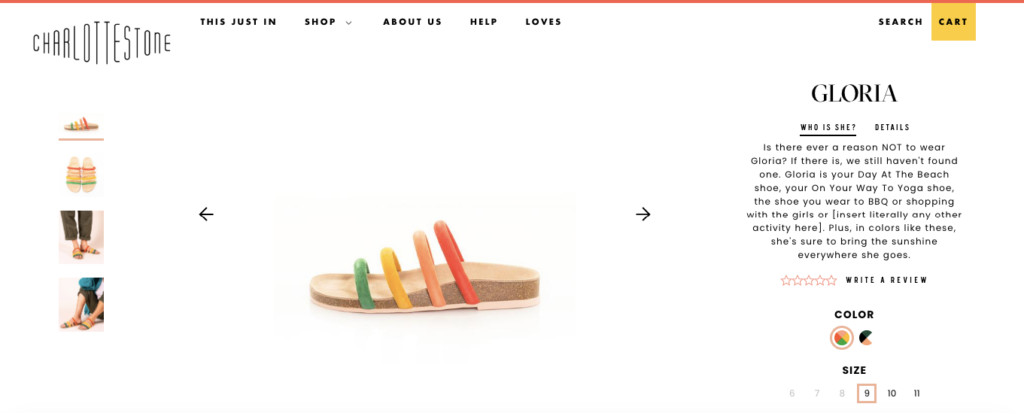 …it appeared later on in my Facebook feed.
…it appeared later on in my Facebook feed.
 The more personalized your retargeted ads are, the better they’ll perform, and the more shoppers you can persuade to return to your site and complete their purchase.
The more personalized your retargeted ads are, the better they’ll perform, and the more shoppers you can persuade to return to your site and complete their purchase.
20. Facebook and the Google Display Network are the Best Platforms for Retargeting
These two platforms have a massive reach.
Facebook reaches 51 percent of all Internet users, and the Google Display Network reaches a staggering 90 percent of all Internet users.
In terms of pageviews, Facebook receives one trillion per month, and the Google Display network receives 180 billion.
So these are definitely the main platforms you’ll want to focus on when retargeting cart abandoners.
With the right approach, you can recover a considerable portion of lost sales.
21. Send 100 SMSes To Recover Up To 16.4 Abandoned Carts
If something valuable slips out of your hand, you can win it back only with the right mindset and strategies.
To win back customers, you don’t have to chase them right after they abandon their carts, but lure them in — with the right incentives.
And research shows that if you effectively use a 60-minute delay, you can potentially recover up to 16.4 orders for every 100 SMS messages you send to customers.
This delay allows customers some time to potentially reconsider their purchase or complete it on their own, without feeling overwhelmed with immediate reminders.
Here’s how you do it the right way:
- Implement cart abandonment tracking on your ecommerce site using tools like Drip;
- Craft personalized, concise, and attention-grabbing SMS reminders to entice the lost customers;
- Introduce a 60-minute delay before sending reminders;
- Offer time-limited incentives like discounts or free shipping or a gift with their purchase;
- Ensure a mobile-friendly website and seamless checkout process as most users access websites via their mobile devices;
- Obtain explicit consent for SMS marketing;
- Segment customers based on behavior and preferences. For example, you can create different messages for new customers, repeat customers, or customers who abandoned high-value carts;
- Utilize automation tools for timely reminders and follow-ups;and
- Conduct A/B testing to compare different SMS message formats, incentives, or delivery times. Also, comply with data protection regulations.
Conclusion
I find the average cart abandonment rate to be alarmingly high. To think that seven out of every 10 shoppers will ditch their cart is unsettling and shows that ecommerce store owners have their work cut out for them.
But it’s certainly an issue that can be corrected. These cart abandonment statistics show some of the most common reasons why shoppers abandon and the specific areas brands need to focus on.
Addressing these key points should help you reduce your cart abandonment rate and redirect a good portion of shoppers that don’t initially complete their purchase.
So in the long run, you can create a better customer experience, boost conversions and build stronger brand loyalty.
One of the best ways to reduce cart abandonment is setting up a cart abandonment workflow. This is the most important automation workflow for growing ecommerce brands – and yet, so many merchants neglect it.
Don’t leave 70% of your sales on the table. Try Drip free for 14 days and take advantage of our ready-made cart abandonment template!
